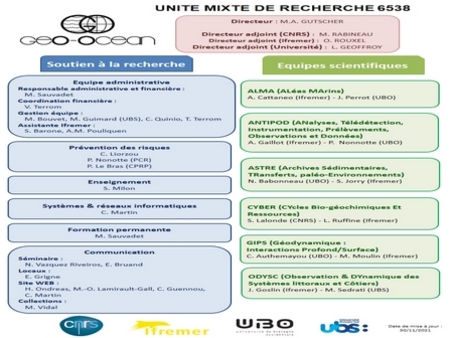Fluids and plumes
The fluid and water column geochemistry team is responsible for deploying the CTD probe, sampling, and in-situ and laboratory measurement of different physico-chemical parameters in the water column, and they notably participate in hydrothermal plume localisation and exploration.
The fluid and water column geochemistry team is responsible for deploying the CTD probe, sampling and in-situ and laboratory measurement of different physico-chemical parameters in the water column, and they notably participate in hydrothermal plume localisation and exploration.
Part of the team is also dedicated to studying the acoustic backscatter of the water column in order to locate hydrothermal plumes from anomalies with multi-beam sounders installed under the ship’s hull and on the UlyX AUV. The team is also involved in the collection and characterisation of pure or diluted hydrothermal fluids using sampling tools and in-situ measurements onboard the manned submersible Nautile. Among the measurement parameters studied by the team are:
- Turbidity, which corresponds to particle content: This is measured in-situ by a sensor called a nephelometer and can indicate the presence of a black smoker and its associated plume.
- The quantities of gases (methane, hydrogen, carbon dioxide) measured onboard in a geochemistry lab. Since these gases are generally present in concentrated quantities in hydrothermal fluids, their presence in the water column may reflect hydrothermal activity in the vicinity (within a few kilometres).
- Total dissolvable manganese (TdMn) which corresponds to the manganese content in the fluid. Hydrothermal fluids are generally highly enriched in metals (including manganese)
In conjunction with cartographers and geologists, and using water column acoustic data (when available), the team determines the site and deployment point of the CTD probe. During the CTD descent, the team analyses any geochemical anomaly (i.e. values for parameters studied in situ that are unusual in this area) and defines the sampling depths to take place during the ascent.
Once the CTD is back on deck, the samples are aliquoted and taken to the laboratory for either direct analysis or later analysis ashore. Some of the samples are analysed on board for their gas content, TdMn, and other parameters such as silicates, pH or total alkalinity. These analyses confirm or not the anomalies observed during the descent by the in situ sensors. Other analyses such as the levels of rare gases or metals are carried out back in the lab in Brest.
During Nautile dives, the onboard scientist chooses to take samples of fluids according to the sites covered (active/inactive, basaltic/ultramafic) and the objectives of the dive. The sampling tools differ according to the fluid. For high-temperature fluids (>150°C)w we use titanium bottles (750 ml) and for lower-temperature fluids an In Situ Sampler, which, as its name indicates, is able to filter samples in situ. Additionally, the scientist can also perform measurements during diving using in situ analyzers called CHEMINI capable of performing measurements for H2S and TdMn content.
- Cécile Cathalot, co-head scientist, researcher in marine biogeochemistry specialised in hydrothermal plumes, Ifremer
- Romain Davy, chemist, in-situ measurements and sampling, analysis of TdMn in the water column, Ifremer
- Jean-Pierre Donval, chemical engineer, gas analysis in the water column and hydrothermal fluids, Ifremer
- Yoan Germain, chemist, analysis of silicates and total alkalinity, analysis of trace metals, Ifremer
- Thomas Giunta, geochemistry researcher specializing in hydrothermal fluids, mineral characterization of fluids, Ifremer
- Vivien Guyader, chemical engineer, water column gas and fluid analysis, in situ measurements, Ifremer
- Carla Scalabrin, researcher in acoustics of the water column, specialist in hydrothermal and volcanic plumes, Ifremer

